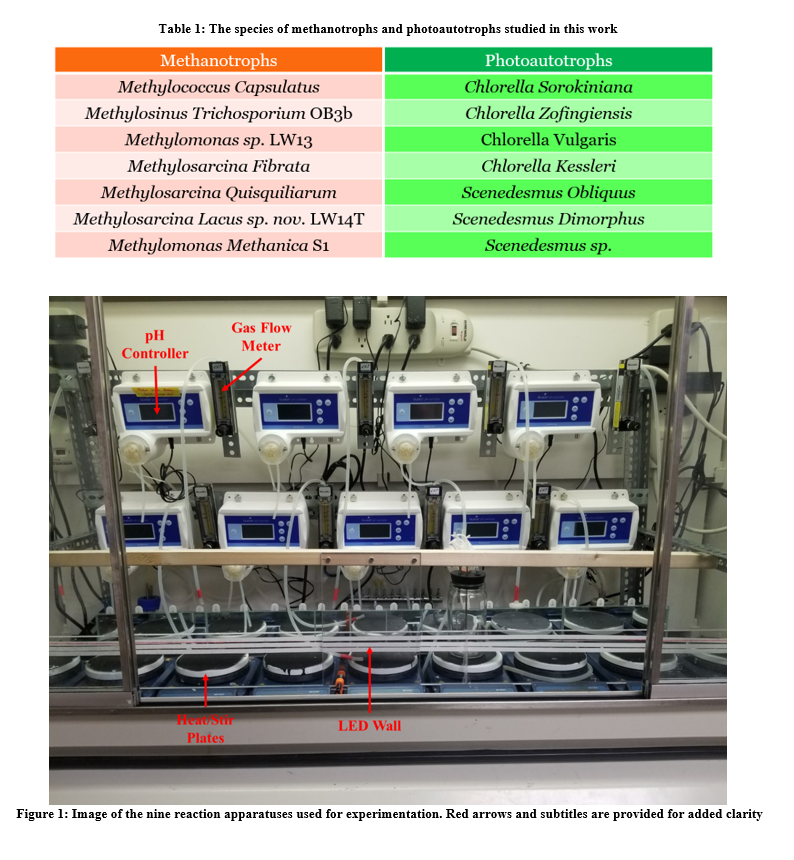2022 Annual Meeting
(312f) Fed-Batch Screening of Methanotroph-Algae Cocultures on Anaerobic Digester Effluent for Larger-Scale Wastewater Treatment and Valorization
Authors
Recently, it has been demonstrated that methanotroph-microalgae cocultures offer a highly effective platform for biogas valorization and nutrient recovery from wastewater [1-3]. As different microorganisms usually exhibit a wide range of native capabilities in terms of growth and tolerance to inhibitors contained in AD effluent, it is important to select and optimize the coculture species for the development of successful waste-to-value biotechnologies. Specifically, the coculture pairs should demonstrate fast and robust growth in the presence of different inhibitors and competitors contained in the AD effluent without sterilization.
To facilitate the selection of the proper coculture strains for the integrated biogas valorization and nutrient recovery, we have developed a screening station which contains nine parallel apparatuses that enable simultaneous testing of multiple species (Figure 1). As temperature, pH, gas feed composition and agitation all have significant effect on the growth of microbes, the screening station must provide nearly identical environments for consistent screening. In addition, light intensity must be regulated for the screening of microalgae and coculture pairs. To achieve uniform conditions across all nine apparatus, different control elements were installed. The variations of temperature and agitation rates were controlled within ±1.0K and ± 10rpm through temperature-controlled stir plates (Four Eâs Scientific). The composition and flowrate of inlet gas were controlled via an in-house gas mixing system [4] and mechanic flowmeters (Cole-Parmer, Masterflex® Correlated Variable-Area Flowmeters). The variation in pH was controlled within ±0.1 through BlueLab pH controller. Lastly, an LED light wall with reflecting mirrors was constructed to provide an even amount of light to each vessel to facilitate photoautotrophic growth. Light intensity was quantified using a PAR meter (Quantum) to verify that each vessel was receiving roughly the same photon flux density within ±10% of the average.
AD effluent from the mesophilic digestor at Columbus Water Works (Columbus, GA) was collected on October 12, 2021, and frozen until needed. Seven methanotrophs and seven photoautotrophs (Table 1) that have been studied for wastewater treatment were selected for screening. Triplicate fed-batch screenings of individual microalgal and methanotrophic species on diluted wastewater revealed which species had the best candidacy for the coculture. Factors taken into consideration were maximum growth rate and organic carbon production. The top three candidates from each species were tested as cocultures (nine cocultures in all) to determine a robust coculture for wastewater remediation. Coculture experiments were also taken in triplicate.
Each 500mL vessel contained 250mL of working volume, starting with an initial optical density of roughly 0.1. Individual vessels were constructed to provide airtight, sterile environments for cell growth. Experiments for this testing proceeded until each culture was at least one day into the stationary phase. The OD was recorded several times a day, while organic carbon measurements were only taken at the start and end of experiments.
References:
[1] Roberts N, Hilliard M, He QP and Wang J (2020) Front. Energy Res. 8, 563352.
[2] Li X, Lu Y, Li N, Wang Y, Yu R, Zhu G and Zeng RJ. (2022) Env. Sci. & Tech. 56 (6), 3669-3677.
[3] Ruiz-Ruiz P, Gomez-Borraz TL, Revah S and Morales M (2020) Chemosphere. 259, 127418.
[4] Stone, K.A., He, Q.P. & Wang, J. (2019) Sci. Rep. 9, 5899.
